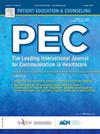Reproductive healthcare professionals’ comfort to treat postpartum patients with substance use disorders
IF 3.1
2区 医学
Q2 PUBLIC, ENVIRONMENTAL & OCCUPATIONAL HEALTH
引用次数: 0
Abstract
Objective
Despite the increasing prevalence of substance use disorders (SUD) in pregnant and postpartum people (PPP), little is known about reproductive healthcare professionals' (RHPs) comfort with SUD counseling, including screening, brief intervention, and referral to treatment (SBIRT). Understanding these factors is essential to improving early identification of SUD and improved care delivery. This study employed a novel Likert-scale survey to assess RHPs’ self-reported comfort with the SBIRT approach for PPP. Qualitative data was collected via open ended questions to explore perceptions of necessary training and resources to enhance support for PPPs with SUDs.
Methods
We conducted a cross-sectional survey with a national sample of RHPs (n = 117). The survey captured comfort in the SBIRT approach in postpartum patient care delivery via two vignettes and associated Likert scales measuring overall comfort. The survey was assessed for validity and reliability. Analysis of free text responses within the survey explored perceptions of necessary training and resources to improve care delivery.
Results
Participants were mostly White (77.8 %) and female (93.2 %), and ages ranged 22–55 years. The opioid, methamphetamine, and overall comfort scales demonstrated strong internal reliability (Cronbach’s α =.83,.81, and.90, respectively). The mean comfort score was 61.35 (SD=10.83). Profession type (p < 0.001), prior SUD-specific training (p = 0.002), and higher SUD patient volume (p < 0.001) were significantly associated with increased comfort. Qualitative themes emphasized the need for expanded perinatal SUD education, stigma reduction, and integrated, trauma-informed care to reduce resource gaps in postpartum screening, mental health services, and peer support programs.
Conclusion
Health professionals report a need for expanded access to postpartum-specific SUD training and increased referral options to assist patients.
Practice implications
Future interventions to increase the comfort and capacity of RHPs for screening, briefly intervening, and referring postpartum patients with SUD are necessary to improve care delivery for this high-risk population.
生殖保健专业人员的安慰治疗产后患者的物质使用障碍
目的:尽管孕妇和产后人群(PPP)中物质使用障碍(SUD)的患病率不断上升,但人们对生殖保健专业人员(RHPs)接受包括筛查、短暂干预和转诊治疗(SBIRT)在内的物质使用障碍咨询的满意度知之甚少。了解这些因素对于提高SUD的早期识别和改善护理服务至关重要。本研究采用了一种新颖的李克特量表调查来评估住院医生自我报告的使用SBIRT方法进行PPP的舒适度。定性数据通过开放式问题收集,以探讨对必要培训和资源的看法,以加强对具有sud的公私合作伙伴关系的支持。方法对全国RHPs样本进行横断面调查(n = 117)。该调查通过两个小短片和相关的李克特量表测量整体舒适度,捕捉了产后患者护理交付中SBIRT方法的舒适度。对调查进行了效度和信度评估。对调查中自由文本回复的分析探讨了改善护理服务的必要培训和资源的看法。结果参与者以白人(77.8% %)和女性(93.2 %)居多,年龄在22 ~ 55岁之间。阿片类药物、甲基苯丙胺和整体舒适量表显示出很强的内部信度(Cronbach 's α =.83,。81年,。90年,分别)。平均舒适评分为61.35 (SD=10.83)。职业类型(p <; 0.001)、先前的SUD特异性培训(p = 0.002)和较高的SUD患者体积(p <; 0.001)与舒适度的增加显著相关。定性主题强调需要扩大围产期SUD教育,减少耻辱感,以及综合的创伤知情护理,以减少产后筛查,心理健康服务和同伴支持计划方面的资源差距。结论:卫生专业人员报告,需要扩大获得产后特定SUD培训的机会,并增加转诊选择,以帮助患者。实践意义:未来有必要采取干预措施,提高RHPs筛查、短暂干预和转诊产后SUD患者的舒适度和能力,以改善对这一高危人群的护理服务。
本文章由计算机程序翻译,如有差异,请以英文原文为准。
求助全文
约1分钟内获得全文
求助全文
来源期刊

Patient Education and Counseling
医学-公共卫生、环境卫生与职业卫生
CiteScore
5.60
自引率
11.40%
发文量
384
审稿时长
46 days
期刊介绍:
Patient Education and Counseling is an interdisciplinary, international journal for patient education and health promotion researchers, managers and clinicians. The journal seeks to explore and elucidate the educational, counseling and communication models in health care. Its aim is to provide a forum for fundamental as well as applied research, and to promote the study of organizational issues involved with the delivery of patient education, counseling, health promotion services and training models in improving communication between providers and patients.
 求助内容:
求助内容: 应助结果提醒方式:
应助结果提醒方式:


